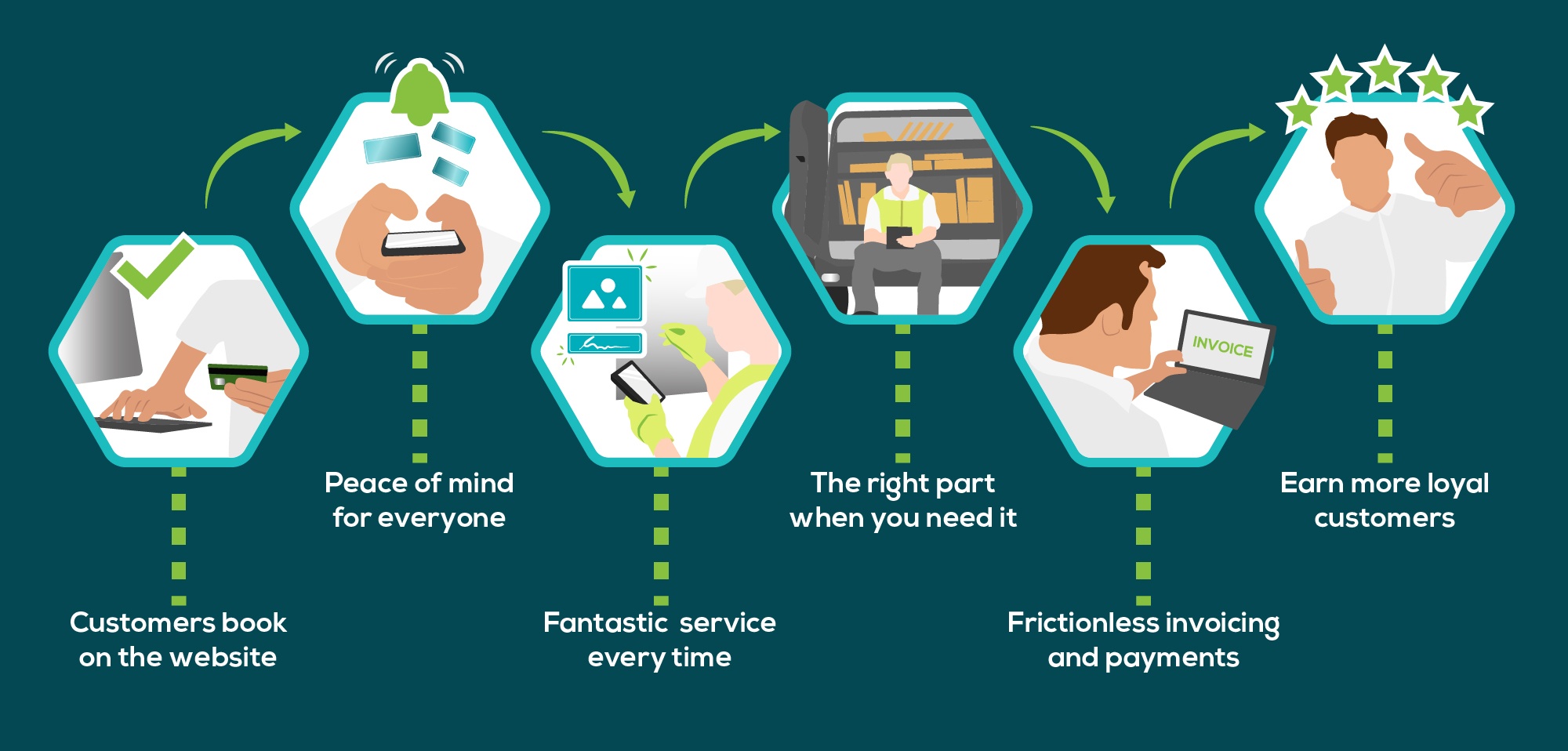
There are more than a few good reasons to improve your customer journeys. They helps you:
- Grow your business
- Make it easier for your employees to do their job
- Save you money in the long run
These benefits sound good, right? Well, there’s even more to it than that…
The greatest impact you’ll make on your overall experience is by improving the individual customer journeys that make up their customer experience.
Knowing this is great, but how exactly will it change the customer experience, we hear you ask?
Well, that’s what we’re going to answer, so let’s get started!

1. How do you map the electrical customer journey?
First of all, it’s important to make sure we’re all on the same page when it comes to the customer journey. Because a service buying process is so very different from your average e-commerce purchase, most mapping guides fail to see the intricacies involved in the process and oversimplify the task to “Customer needs an electrician. Customer hires an electrician.”
The truth is that most service customer journeys follow the map you can see below, where each touchpoint is a journey in and of itself:

To improve each phase of an electrical contractor’s customer experience with software tools, we’re going to follow the individual journeys highlighted above. Let’s start by looking a booking a job.
2. How do commercial and residential customers want to book an electrical contractor?
Phone, email, online booking portal, walk-in (for those who have a shop front), text, and, really any other way you can think of – all of these are ways for customers to book your services and it helps to have a selection of them (if not all). There’s no one booking method to rule them all; instead it’s about offering choice (and this will be a theme throughout the article), especially to residential customers. Variety is the spice of life, so they say, and it’s undoubtedly a great way to make people happy. Checkfront lists a series of great reasons why online booking is great, while Fonolo thinks phones aren’t going away any time soon.
A software will help you improve the electrical customer journey by taking care of the booking through a portal and recording information about the job which will make things that much easier for your admin. At the same time, even for customers who call in or send emails, software will speed up the process by making it easy to find the relevant data quickly and so create a more seamless experience for the customer and for your team.
Commercial customers, on the other hand, have different expectations of their hired electrical companies. This is particularly the case if you work with property managers who handle hundreds or thousands or addresses. In the past, this used to be dealt with by a long stream of back-and-forth emails (or, worse, phone calls!) between the tenant, the property manager, and the electrical contractor which took a lot of time and admin effort.
A much better commercial booking journey would be for a property manager to be given access to a customer portal where they can book a job with you. There you’ll see the address and tenant details so you can email the tenant a booking portal link, where they can choose their own date and time in a matter of minutes. No more back-and-forth!
3. What do customers want from an electrical contractor before they arrive at the job?
Sending reminders beforehand (e.g. one week before, three days, and on the day itself) with an exact service window is ideal, not only to actually remind customers of when they’re supposed to have an electrician around, but also to give them peace of mind that everything is going according to the outlined schedule.
This also helps you to reduce situations like no-access jobs that will only waste your techs’ time, fuel, and put more stress on your admin to reorganise.
Just think of how many emails Amazon sends you when you purchase even the most insignificant of items. They can be very useful as you know exactly what’s going on and feel in control of your experience. Your customers probably use Amazon and other similar services, too, and it’s true that customers are now expecting other service-giving businesses to deliver similar experiences.
Of course, manually sending all these reminders and confirmations is a sure way to frustrate your admins. Not only that, but if you stuck with a manual method, you’d have to hire dozens of people to keep up with all your customers, especially as you grow.
You don’t need Amazon-level software to cope though even the most basic software will be able to automate such tasks for you and keep customers in the loop without much admin effort at all.
4. How do you offer the best customer experience while on the job?
You start by doing some great work, of course! That’s never going to change and as an electrician, you have a great deal of responsibility to make sure your expertise is up to standard.
This being said, it’s the sad reality that most customers can’t tell the difference between a great job and an average one, unless something breaks down (in which case, that’s definitely below-average work).
It’s easy to see that a customer’s experience greatly depends on details such as the electrician arriving on time (or informing them that they’ll be late if that’s the case), being courteous and cleaning up when they’re done, having the right parts for the job on hand, etc. All it takes is a look at other contractors’ reviews to see that most 3-star feedback comes not from shoddy workmanship but poor customer service.
In order to deliver a frictionless experience, a business owner will need to train electricians to use their soft skills (friendliness, politeness).
They’ll also need to provide software tools that further enhance everyone’s experience. This could be through things like letting customers see where an engineer is on a map, or allowing engineers to track and manage parts and inventory to see where items are at any point in time.
You could also use software to create custom forms and checklists that standardize the service they provide. For example, when an electrician selects “Done” on their mobile app, a form can pop-up to ask if they’ve informed the customer of the best practices for using an appliance, or simply to check if they’ve cleaned up the work area.
5. What types of quotes are likelier to be approved by customers?
You’d expect the answer to be “the cheapest quotes” but allow us to subvert your expectations here.
Have you noticed how almost every service that’s become an integral part of your life at this point (from Netflix to, yours truly, Commusoft) runs a tiered pricing list? It goes back to – you guessed it – giving customers a choice that makes them feel in control.
Electrical contractors can easily make use of the “good, better, best” pricing strategy to offer customers the best for them while at the same time ensuring they stay profitable. Software can be a great tool to illustrate these options, as many quoting features can produce on-the-spot quotes with visual breakdowns of the costs. Electricians with access to their software’s mobile app can then present multiple options to a customer and let them pick the most suitable one.
6. How do customers want to pay in an ideal electrical customer journey?
If you look at the heading above, you’ll notice it’s not “How do you want to be paid”. Offering choice (as said at the start of this article) is key to making customers happy because it gives them the feeling of control. It’s all part of the ideal electrical customer journey.
Indeed it could be more convenient for you to take only cash, or to exclusively wait for bank transfers, but the hard truth about delivering the perfect customer experience is that it’s not about you. If you’ve seen that look on people’s faces one too many times when telling them you only take cash, then we’re here to say it’s already high time to take a look at mobile payment devices.
Generally, these devices do charge a fee (approx. 2.5% of the transaction) but they deliver the payment straight to your bank account, with no need to drive to the bank and pay for depositing cash or cashing checks. Not to mention they spare you the worry of driving around with large piles of cash.
So, once you’ve hit a certain number of customers and can’t afford to be driving around all day with a glove box full of cash, as well as made peace with the fact that payment fees are a normal cost of doing business (like paying for tools and fuel), payment devices can significantly improve the customer experience you offer that’s well worth the fee.
An electrical contractor software should account for these payment devices and make things even smoother by being the link between them, your accounting tool, and your customer database software.
This way, information is recorded automatically, all your financials are accurate, and your admin doesn’t waste any time on any part of the payment process.
Oh, and did we mention invoices are sent automatically?
7. Do your customers want to give feedback?
Yes, always. Everyone’s got an opinion nowadays and they want to make sure it’s shared with the whole wide world, for better or worse. This being said, some service companies still find it difficult to gather reviews mostly because while customers do want to share their opinions, they’re not going to go out of their way – at least not for a positive review.
This means that if you simply wait around for reviews to come in, you risk getting more negative ones because unhappy people (and everyone gets one of those from time to time, regardless of how great your work is, so don’t worry about it!) are a lot likelier to want to shout it from the rooftops.
Asking for a review in a post-appointment email is the easiest and most convenient way to get more positive reviews from your customers, especially if you directly link to a preferred aggregator site like Google Reviews, HomeAdvisor, Angie’s List, or any other website you think is relevant. Don’t spread yourself too thin though, especially if you’re just getting started with reviews. This ensures you don’t end up with reviews scattered across the internet, which can make your company look smaller than it really is.
You’ll be pleased to hear that automating these feedback request emails is a breeze with software. Ideally, you’d send out a simple email after each job to gauge whether the experience was positive or negative (for example, with a basic thumbs up/down query).
This way, your software can follow up the positive experiences with other automatic emails containing a link to your review aggregator of choice, while your admin can get in touch with those who said they had a negative experience and patch things over.
Perfecting your electrical customer journey
At the end of the day, what everyone wants to feel is special. Software and good processes can only take you so far, but if you don’t prioritize the customers in your attitude and work ethic, ensuring satisfaction will definitely be a challenge.

Cristina Maria
I'm here to bring you next-level strategies to the field service industry. When I'm not working on the best tips to grow your business, I'm on the lookout for sci-fi novels and cookie recipes.








